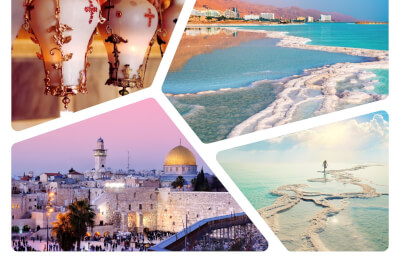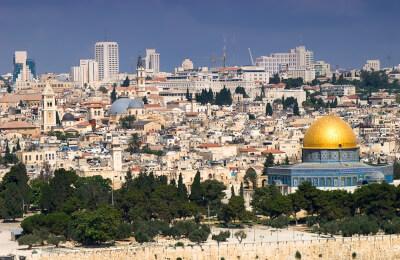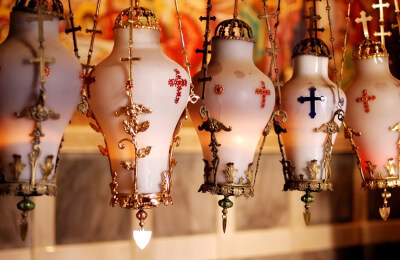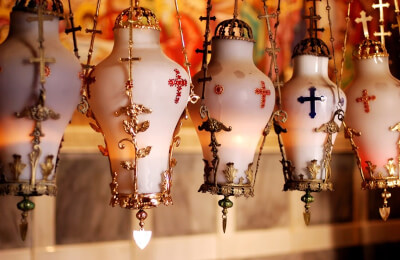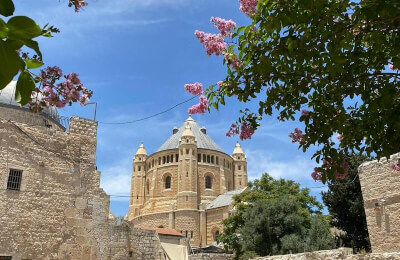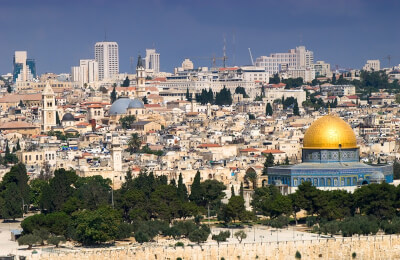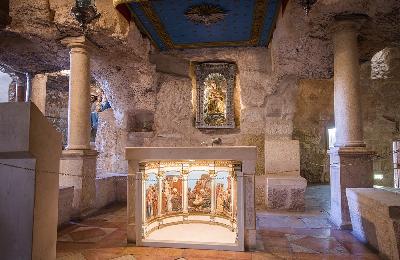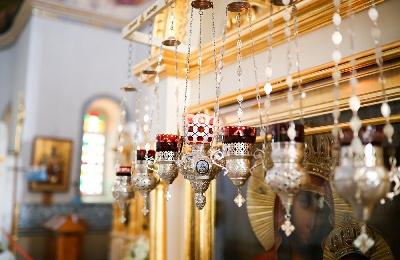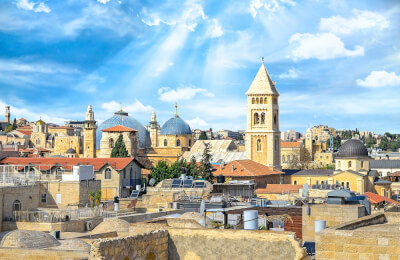
42. Walking Jerusalem Promotion
1. Christian Jerusalem Promotion

2. Jerusalem of three religions Promotion
4. Jerusalem Underground Promotion
5. Bethlehem and Christian Jerusalem Promotion
We also found excursions from other cities that are close to your departure city
Other excursions that also deserve your attention
Church of the Holy Sepulchre: A Spiritual and Historical Icon in Jerusalem
Introduction
The Church of the Holy Sepulchre, situated in the heart of Jerusalem's Old City, stands as one of the most sacred and revered sites in Christianity. This historic church holds within its ancient walls a rich tapestry of faith, history, and devotion that spans over a thousand years. In this exploration of iconic sights in Israel, we delve deep into the spiritual and historical significance of the Church of the Holy Sepulchre, uncovering fascinating facts and stories that make it a must-visit destination for pilgrims and tourists alike.
The Church of the Holy Sepulchre: A Testament to Faith
1. Historical Significance
The Church of the Holy Sepulchre is synonymous with the events surrounding the crucifixion, death, and resurrection of Jesus Christ. It is believed to encompass both Golgotha, where Jesus was crucified, and the tomb in which he was laid to rest before his miraculous resurrection. The significance of these events is central to Christian theology, making the church a destination of immense importance for Christians worldwide.
a. Constantine the Great: The church's history dates back to the fourth century when it was commissioned by Emperor Constantine the Great. He ordered the construction of a grand basilica on the site, effectively marking it as the place of Jesus' crucifixion and burial. The church was consecrated in 335 AD.
b. Historical Resonance: The church's location is believed to be where the most profound events of Christianity occurred, making it a place of deep spiritual resonance for pilgrims and the faithful.
2. Religious Significance
The Church of the Holy Sepulchre is the epicenter of Christian faith, and its interior is a testament to devotion, prayer, and the diversity of Christian denominations.
a. The Aedicule: At the heart of the church lies the Aedicule, a small shrine that houses the tomb of Jesus Christ. Pilgrims from various Christian traditions visit this sacred spot to pray and pay their respects. The tomb is encased in a marble structure, which was renovated in 2017 to preserve the historic site.
b. Ecumenical Cooperation: The church serves as a symbol of cooperation and coexistence among different Christian denominations. Six Christian groups share custody of the church: the Greek Orthodox, Armenian Apostolic, Roman Catholic, Coptic Orthodox, Ethiopian Orthodox, and Syriac Orthodox. The Church of the Holy Sepulchre is a symbol of their commitment to preserving and protecting this holy site.
3. Architectural Grandeur
The architecture of the Church of the Holy Sepulchre is a reflection of centuries of history, faith, and cultural influences.
a. The Rotunda: The church's interior is a stunning combination of intricate mosaics, ornate decorations, and candlelit ambiance. The Rotunda, which houses the Aedicule, is crowned by a majestic dome adorned with an oculus, allowing a heavenly light to filter through.
b. The Stone of Unction: As visitors enter the church, they encounter the Stone of Unction, traditionally believed to be the place where Jesus' body was prepared for burial. Pilgrims often lay their hands on the stone or anoint it with oil as an act of devotion.
4. Historical Events
Throughout its history, the Church of the Holy Sepulchre has witnessed numerous historical events, some of which have left an indelible mark on its structure and traditions.
a. Fires and Rebuilding: Over the centuries, the church has suffered destruction and fires. The church you see today is the result of extensive renovations and rebuilding efforts carried out by various Christian denominations.
b. Status Quo Agreement: In 1757, the Status Quo agreement was established to regulate the control and use of the church's various areas and facilities among the Christian communities. This agreement is still in place today, highlighting the church's role as a symbol of cooperation and unity among Christian denominations.
Interesting Facts about the Church of the Holy Sepulchre
1. The Immovable Ladder: A wooden ladder has stood on a ledge above the church's entrance since at least the early 18th century. This ladder has become a symbol of the Status Quo agreement, as its placement signifies that nothing within the church can be altered without the consensus of all the Christian denominations.
2. Miracle of the Holy Fire: Each Easter Saturday, according to Eastern Orthodox tradition, a miraculous event known as the "Holy Fire" occurs within the Aedicule. It is believed that a divine fire emanates from the tomb of Jesus, lighting candles held by the Patriarch of Jerusalem.
3. The "Omra": Within the church, there is a small chapel known as the "Omra." This is believed to be the spot where Mary Magdalene encountered the resurrected Jesus.
4. Architectural Marvels: The church houses a vast collection of Christian art and relics. The Iconostasis, a screen adorned with icons separating the sanctuary from the nave, is a remarkable example of Byzantine artistry.
5. Beneath the Church: Beneath the present-day church, there is a complex network of caves, tunnels, and chambers that have been the subject of archaeological exploration. Some of these spaces date back to the time of Jesus.
Visiting the Church of the Holy Sepulchre
Visiting the Church of the Holy Sepulchre is an experience that should be approached with respect and reverence. Visitors are encouraged to dress modestly and quietly observe the various areas of the church, as it is a place of ongoing worship and devotion for many.
It is advisable to check the opening hours and any specific visiting restrictions, as the church may be closed for religious services and events. Additionally, it's important to be aware of local customs and adhere to the guidelines provided by church staff.
Conclusion
The Church of the Holy Sepulchre is not merely a place of worship; it is a testament to the enduring power of faith, devotion, and unity among Christian communities. This sacred site stands as a symbol of history, spirituality, and cooperation, and its story is intertwined with the very foundations of Christianity itself. A visit to the Church of the Holy Sepulchre is not only a journey through time and faith but also an opportunity to witness the profound impact of this iconic place on the hearts and minds of pilgrims from all corners of the world. It is, without a doubt, a must-visit destination for anyone exploring the cultural and spiritual heritage of Israel.









